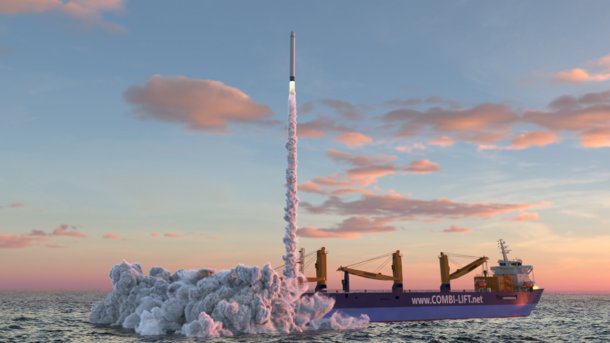Spaceport: rocket launches in the North Sea from summer
Following delays, an alliance led by Bremen-based space technology group OHB plans to launch the first small rockets from a floating platform in the near future

So far, rockets have only been launched in the North Sea in computer graphics.
(Bild: German Offshore Spaceport Alliance)
The floating launch platform for small carrier rockets in the North Sea, which has been planned for several years, is due to commence operations on a trial basis this summer. In October, it was still said that it would start in April. However, this deadline could not be met. The planned demonstration mission will now take place in mid-June or July, explained Marco Fuchs, CEO of OHB, at the Bremen-based space technology group's annual press conference on Tuesday, according to reports. OHB is one of the members of the German Offshore Spaceport Alliance (GOSA), which operates the maritime rocket launch site and thus also wants to open up a future market for a growing number of start-ups and medium-sized companies from the "New Space" segment.
An OHB spokesperson confirmed the new expected date of the demo to heise online. The postponement of a few months was due to the approval process, among other things. However, OHB is now confident that it will be able to get started.
Four rockets are to be launched during the two-week test. The largest is the Fornax of the Danish Student Association for Rocketry (DanStar) with a length of 4.53 meters and a diameter of 203 millimeters, which is to fly 8.77 kilometers high. In the midfield are the Nova 1 from the Friends of Amateur Rocketry (FAR) and the Aquila from Space Team Aachen, for which flight altitudes of around 12 and 10 kilometers are specified. As a lightweight with a dead weight of 15 kilograms, the four-metre-high SDART from T-Minus in the Netherlands is expected to reach a distance of around 42 kilometers from Earth.
All the planned flight altitudes are still a long way from space. The Fédération Aéronautique Internationale (FAI) has defined the boundary between air and space at an altitude of 100 kilometers ("Kármán line"). However, with the suborbital rocket launches and the associated smaller research missions, the alliance wants to gain practical technical experience and know-how in order to implement more complex launches in the future and bring small satellites into space "simply, reliably and cost-effectively". Each launch is to be accompanied by a control ship and a new multifunctional control center in Bremen in order to keep a close eye on the weather and conditions on site, for example. GOSA also wants to use this infrastructure for future missions and test it as part of the "high-altitude research flights".
A German spaceport is to be built in the North Sea
GOSA wants to set up a mobile launch platform for so-called micro-launchers in order to meet the growing demand on the market for small commercial satellites. According to GOSA, four times as many of these earth satellites will be launched this decade than in the previous one. This will lead to bottlenecks in land-based launch pads. This is why the operation of an additional European launch infrastructure at sea is so crucial. With this, a special launch ship is to launch the missiles around 350 kilometers off the German coast while still within the sovereign territory of the Federal Republic of Germany.
OHB CEO Fuchs believes that Germany is well positioned when it comes to micro-launchers. An offshoot of the Bremen-based company, Rocket Factory Augsburg (RFA), has been working on the three-stage small rocket RFA One for years. It is now set to be launched for the first time on August 1 at the earliest from SaxaVord Spaceport on the Shetland Islands. Initially, the launch date was the end of 2023. In June, RAF also signed a binding agreement with the French space agency CNES to additionally launch from the Kourou spaceport in French Guiana.
Fuchs also expressed his appreciation for competitors Isar Aerospace from Bavaria and HyImpulse from Baden-Württemberg, which are developing their own micro-launchers. OHB surprised the public last year with the announcement that it had brought US financial investor KKR on board. The latter intends to contribute 338 million euros and thus become a major shareholder. 30 million of this is to go to RFA to enable its small rocket to take off.
(anw)